Some of the links below are affiliate links, which means that if you click on them and then buy something, I will get paid for it. Regardless, I only link to products we use on our homestead or believe in.
Learn how to can green beans the easy way using the raw pack method. This is the perfect guide for people who have never canned before or who want to keep their fresh green beans for all year without having to do a lot of work. Home canning just got a little bit easier!.
Green beans are a delicious vegetable that can be enjoyed year-round when properly preserved through canning. Many people wonder if it’s possible to can green beans safely without using a pressure cooker. The short answer is yes, you can can green beans without a pressure cooker if you pickle them first to increase acidity. Let’s explore this in more detail.
An Overview of Canning Green Beans
Canning green beans allows you to enjoy their crisp fresh taste long after the growing season ends. The canning process kills any bacteria or microorganisms that could cause spoilage creating a shelf-stable product.
However, different canning methods are required depending on the acidity level of the food. Green beans are low in acidity, with a pH above 4.6. This puts them in the “low-acid” category for canning purposes.
Low-acid foods like green beans must be processed at temperatures of 240°F or above. This high heat can only be achieved through pressure canning where the pressure allows temperatures to rise above boiling point.
Pressure canning green beans creates a safely preserved product that can be stored for up to a year. However, not everyone has access to a pressure canner. So is there another way?
Pickling Green Beans to Increase Acidity
The acidity level is the key factor. While regular green beans are low-acid pickling boosts acidity lowering the pH below 4.6 and creating a high-acid product.
Pickled green beans can then be safely processed using a water bath canning method, as the increased acidity prevents bacterial growth even without the high heat of pressure canning.
To pickle green beans, you’ll need:
- 1 lb fresh green beans, trimmed
- 1 cup white vinegar
- 1 cup water
- 1 tbsp pickling salt
- Optional seasonings – garlic, dill, peppercorns
Pack trimmed green beans into sterilized jars. Bring vinegar, water, salt and any seasonings to a boil. Pour the hot brine over the beans leaving 1⁄2 inch headspace. Remove air bubbles, wipe rims, and seal jars.
Process the pickled green beans for 10 minutes in a water bath canner filled with enough warm water to cover the jars by 1-2 inches. Once cooled, the pickled green beans can be stored up to a year.
Step-by-Step Guide to Pickled Green Beans
Follow these simple steps for safely canned pickled green beans without a pressure cooker:
1. Sterilize your jars and lids
Wash jars and lids in hot, soapy water. Rinse well. Place jars in a large pot filled with enough water to cover them. Bring water to a boil and boil 10 minutes. Keep jars hot until ready to fill.
2. Wash and trim green beans
Rinse beans under cold water. Snap off ends and trim to desired size. Keep beans uniform for even cooking.
3. Pack jars with green beans
Pack trimmed green beans vertically into hot, sterilized jars. Leave 1⁄2 inch headspace between beans and rim.
4. Make the pickling brine
Bring vinegar, water, salt and any seasonings to a boil. Reduce heat and simmer 5 minutes.
5. Pour brine over beans
Ladle hot brine into packed jars, again leaving 1⁄2 inch headspace. Slide a non-metallic utensil along jar sides to release trapped air bubbles.
6. Wipe rims, apply lids and rings
Use a clean, damp cloth to wipe any brine off jar rims. Center lids and screw bands on just fingertip tight.
7. Process jars in a water bath
Place jars in canner filled with warm water by 1-2 inches. Bring to a boil. Process pint jars for 10 minutes at a rolling boil.
8. Cool and store
Turn off heat. Use a jar lifter to transfer jars to a towel. Leave undisturbed 24 hours. Check seals, then store in a cool, dark place up to a year.
And that’s all there is to it! With these simple steps, you can safely can crisp pickled green beans without the need for a pressure canner.
Tips for Delicious Pickled Green Beans
Follow these tips for optimal flavor and texture:
-
Choose tender, slender green beans. Fatter beans can become hollow and mushy when pickled.
-
Keep beans uniform in size so they pickle evenly. Cut into similar lengths.
-
For a crisper texture, soak beans in ice water for a few hours before pickling.
-
Use white vinegar for the brightest color. Cider vinegar works too. Avoid darker varieties.
-
Play with seasonings! Try dill, garlic, peppercorns, chili flakes, mustard seeds or coriander.
-
Store pickled beans at least 2 weeks before eating for best flavor development.
The Benefits of Canning Your Own Pickled Green Beans
Preserving your own pickled green beans has many advantages:
-
Cost savings: Home canning is economical compared to store-bought canned goods.
-
Control ingredients: You can avoid unwanted additives like preservatives, colors and flavors.
-
Customize flavors: Adjust spices to suit your taste preferences.
-
Quality: Home-canned beans maintain crisp texture and fresh flavor.
-
Safety: Follow proper canning methods to ensure safely preserved foods.
-
Sustainability: Preserving surplus produce prevents food waste.
So don’t let a lack of pressure canner stop you from canning green beans! With pickled green beans, you can safely can using a simple water bath method. The result is deliciously preserved green beans all year long. Give it a try!
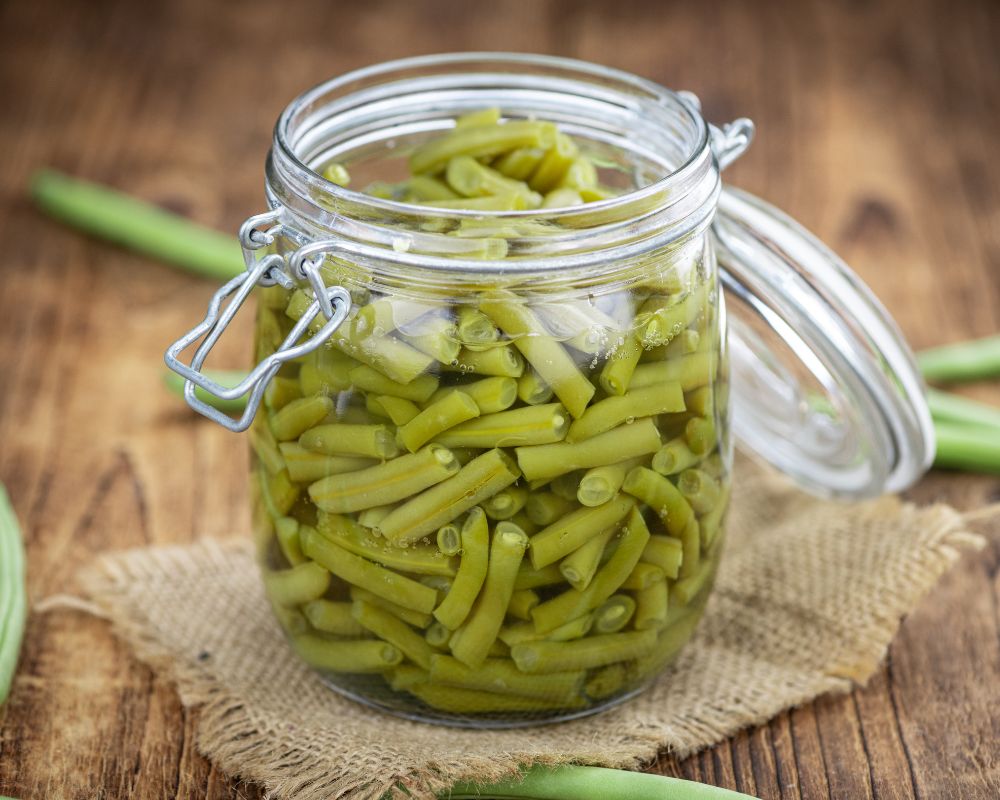
How to Can Green Beans
- Pressure Canner— Green beans are a low-acid food, so you can’t use a water bath canner. Instead, you need to use a pressure canner to get them to the right temperature. I love my All-American Pressure Canner. You don’t know which pressure canner to buy? Read this to find the best one for your cost and type of stove.
- Jam Jars: Choose the jar size that works best for your family (think about how many servings you want). Jars the size of pints hold enough green beans for my family of four.
- Tomato Lids and Bands—I buy my tomato lids in bulk sleeves here.
- Canning Tools—I love my canning tools, like a lid lifter, jar lifter, bubble remover, and so on. They make the canning job easier (and safer).
- Kitchen Towel—Once you’re done canning, you’ll want to put a kitchen towel on the counter. This keeps your jars from getting thermal shock and also keeps them from breaking or cracking.
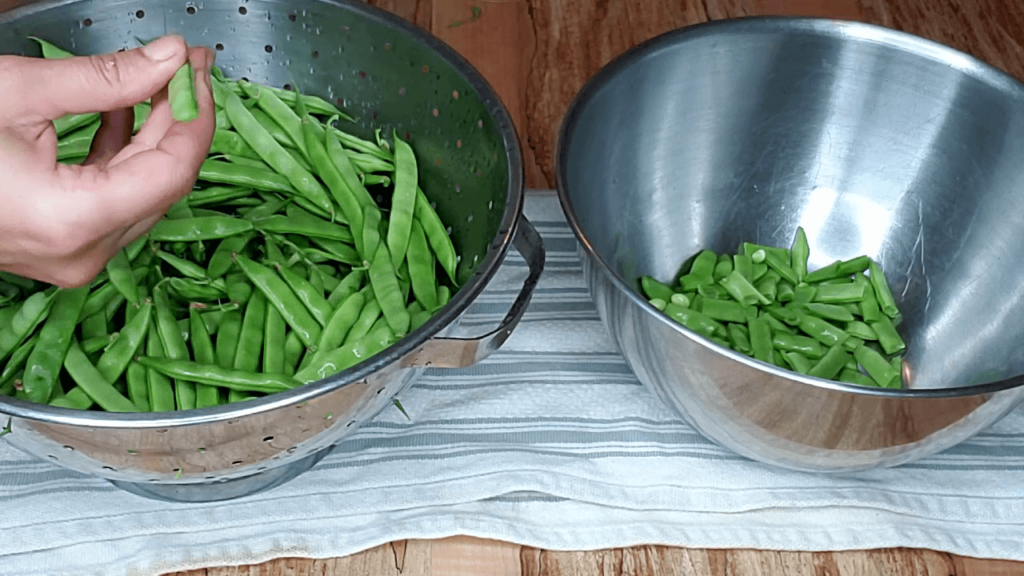
- Fresh Green Beans—For every pint (or quart), you’ll need about 1 pound of green beans.
- Salt—You don’t have to use salt, but I think you should. No one wants beans that don’t taste good, so I use Redmond Real Salt for everything, especially when I can them. Please use that link and the coupon code 20%E2%80%9CPioneering%E2%80%9D to get 15% off your order.

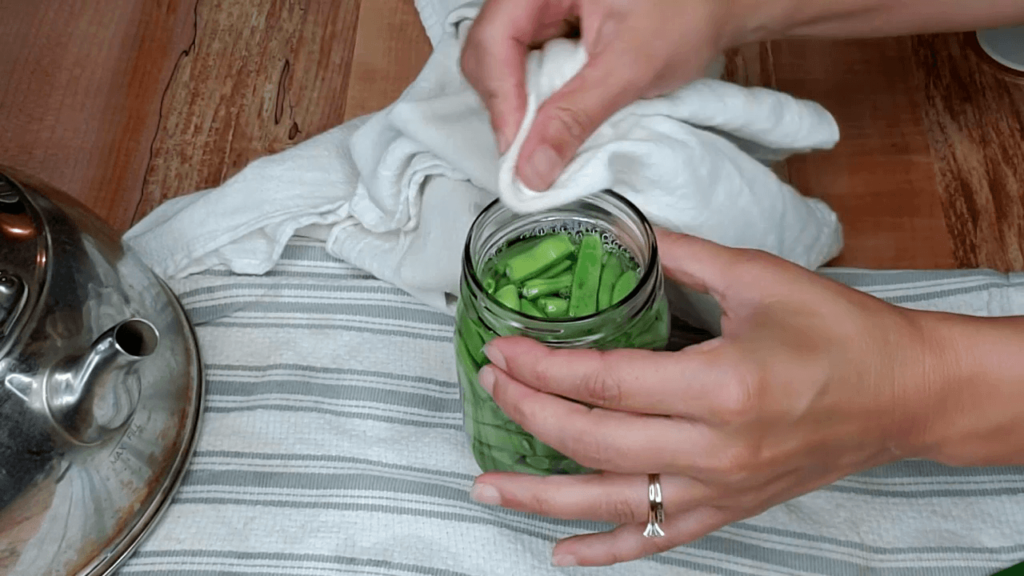
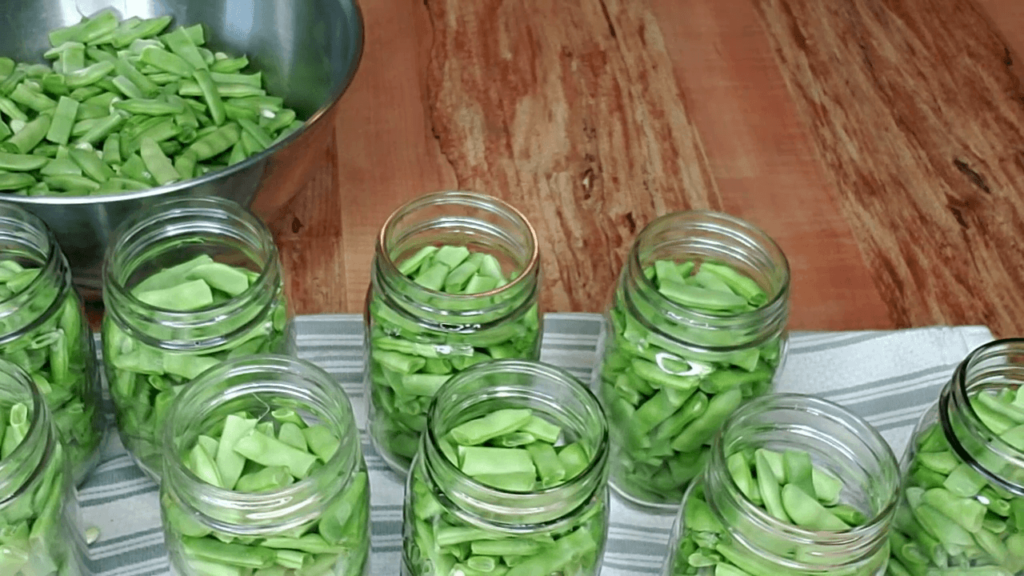
- Pick your green beans. Avoid canning beans with blemishes or rust spots. Choose beans that are tender and crisp when snapped. When picked in the morning, the beans will be the crispiest.
- Rinse green beans thoroughly, then drain off excess water.
- If the beans are string type, cut off the ends and string them. Then, snap them into 1 to 1 and 1/2 inch pieces.
- Put the pressure canner on the stove and add hot water and a rack. It’s faster to start with hot water than cold water. There should be about 2 to 3 inches of water in the bottom of your pressure canner.
- Make sure the water stays at 140 degrees Fahrenheit by setting the burner to medium heat.
- Bring water to a boil in a kettle or large pot.
- Hand wash the Mason jars and lids in hot soapy water. Then, lay them out on a clean kitchen towel. Pro Tip: DO NOT boil the lids. The rules for canning lids changed in 2014, and boiling the lids can make them less likely to seal. As long as you process the jars for 10 minutes or more, which you definitely do when pressure canning, you don’t need to sterilize the lids or jars.
- Leave a 1-inch gap between the top of the green beans and the top of the Mason jar when you fill it with green beans.
- For every pint or quart jar, add 1/2 teaspoon of salt. (Salt is optional but does provide better flavor). Do not use regular table salt; instead, use canning salt or sea salt that does not have any anti-caking ingredients or agents added to it.
- Pour or ladle boiling water over the green beans until the water level reaches the 1-inch headspace around the beans.
- If you don’t have a canner bubble/headspace tool, you can use a ruler instead. Run the ruler between the glass and the food to get rid of air bubbles. Re-measure your headspace and add extra water if needed.
- Clean the rim of your glass jar with a damp cloth or paper towel. This helps make sure that there is nothing that can stop a seal from forming.
- Put the lid and canning band on the jars that are full, and then tighten the bands until they are fingertip tight. (Find out what fingertip tight means here.) If you tighten the bands too much, the lids may buckle.
- Place in the prepared pressure canner.
- Put the lid on the pressure cooker and let it sit for 10 minutes to let the steam out.
- Fill the tank with air, then add a weighted gauge or jiggler/rocker and let the pressure build up slowly.
- Raise the pressure to the right number of pounds per square inch for your altitude (see graph above for help) and process for 20 minutes for pint jars or 25 minutes for quart jars.
- After the jars are canned, take them out and place them on a towel-lined surface.
- Let the jars sit for 12 to 24 hours before taking off the bands, wiping them down, putting labels on them, and dating them.
Place lid on the pressure canner and allow to vent for 10 minutes. Then, put the right amount of weight on the pressure canner for your elevation and process for 20 minutes for pint jars or 25 minutes for quart jars. Remove from canner and place on a towel-lined surface. Leave the jars to sit for 12 to 24 hours following pressure canning protocol.
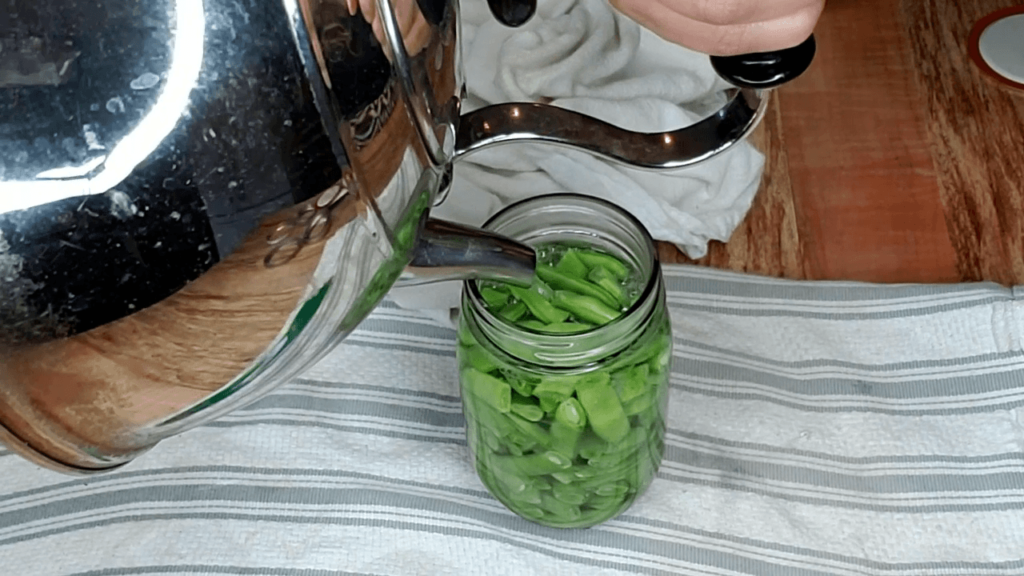


Green beans are a low-acid vegetable and must be pressure-canned. Water bath canning is not safe. Adding vinegar to green beans makes the pH level drop to 4, which is the only safe way to water bath can them. 6, making them safe to water bath can.
You want to avoid food waste (or potential botulism) at all costs. Learn more about botulism and safe canning practices here.
Food that was canned at home should be used within a year, according to the National Center for Home Food Preservation. But if you store canned goods out of direct sunlight and below 90 degrees Fahrenheit and follow tried-and-true steps, they will last for years.
We rotate our pantry items and try to eat all of our home-canned food within 18 months. However, there have been times when we’ve opened jars older than that and the food was still fine.
I prefer to use the raw pack (or cold pack) method of canning green beans. It requires less work on my part and is an approved and tested method. The green beans can also be blanched in boiling water for 5 minutes before being put in jars and processed in a pressure canner. This is called the “hot pack” method.
This goes along with the question above. Yes, you can hot-pack green beans. To do this, just boil them for 5 minutes and then put them in jars and process them in a pressure canner.
No, salt is completely optional, but definitely adds to the great flavor of green beans. If you’re concerned about salt, you can omit it.
According to the National Center for Home Food Preservation, those at 2,000 feet of elevation and below should pressure can beans at 11 pounds with a dial gauge or 10 pounds with a weighted gauge. Check the NCHFP canning chart to adjust for altitude.
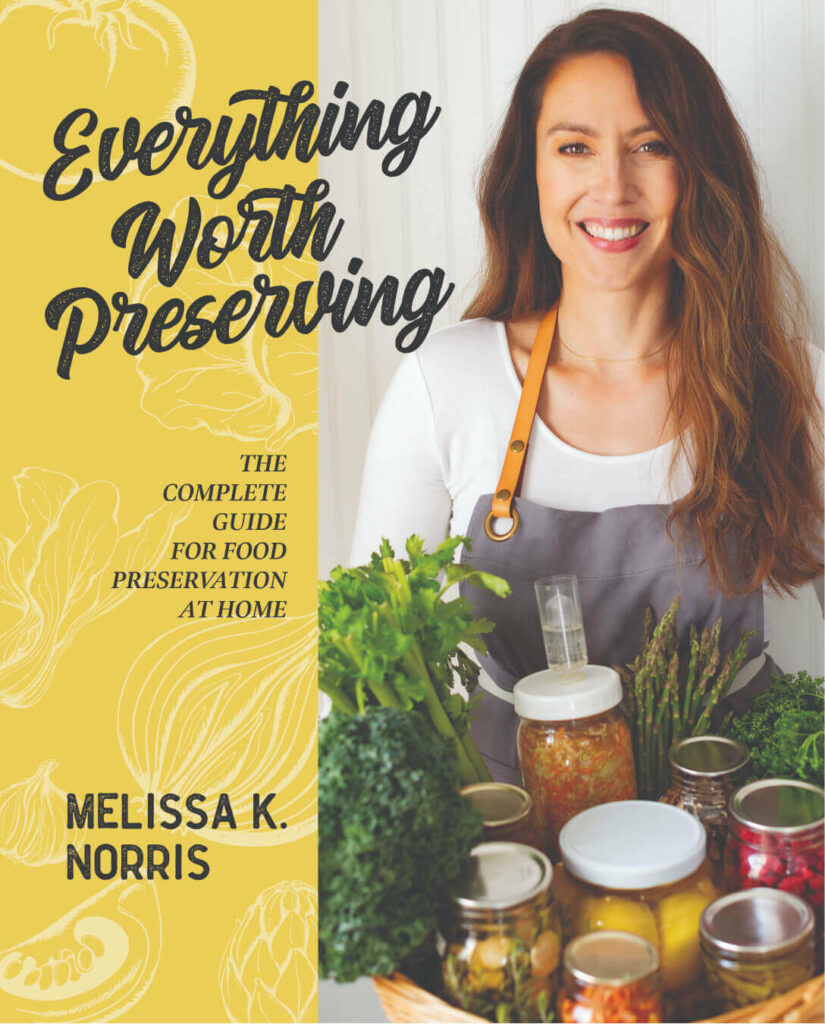
Discover nine different home food preservation methods to safely store delicious food for year-round eating. My book Everything Worth Preserving includes step-by-step tutorials, recipes, and easy-to-use charts.
Read on to find out everything you need to know about freezing, dehydrating, fermenting, pressure canning, salt/curing, root cellaring, and water bath/steam canning.
This book is great for people who have never canned before because it has lots of other recipes like this green bean tutorial.
More Posts You May Enjoy
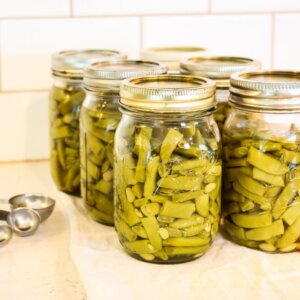
How to can Green Beans Without a Pressure Cooker
FAQ
How to canned beans without a pressure cooker?
How do the Amish can green beans?
How to can without a canner or pressure cooker?
How to can green beans without a pressure cooker?
There are two ways of packing to consider for canning green beans without a pressure cooker. These two methods are hot packing or cold packing. If you choose to use the hot packing method, you must first boil your beans in hot water for five minutes or so. After the green beans are ready, drain the water and place your beans into the prepared jars.
How do you brine green beans without a pressure canner?
To create a brine solution for canning green beans without a pressure canner, you’ll need to combine water, vinegar, and salt in a large pot. The standard ratio for a brine solution is 1 cup of water to 1 cup of vinegar and 1 tablespoon of salt. Adjust the quantities based on the amount of green beans you’re canning.
How do you can green beans in a pressure canner?
Rinse green beans thoroughly, then drain off excess water. Trim off ends, string if beans are a string variety, and snap into 1 to 1 and 1/2 inch (bite-sized) pieces. Place pressure canner on stove-top and fill with rack and hot water (it’s faster to start with hot water instead of cold water).
Can You pressure can green beans?
The first thing you should do before you can the green beans is to thoroughly wash the beans, whether or not you are using a pressure canner. Make sure that you thoroughly wash the green beans in cold or cool water. After washing the beans lift them from the wash water and throw away any garden debris.
